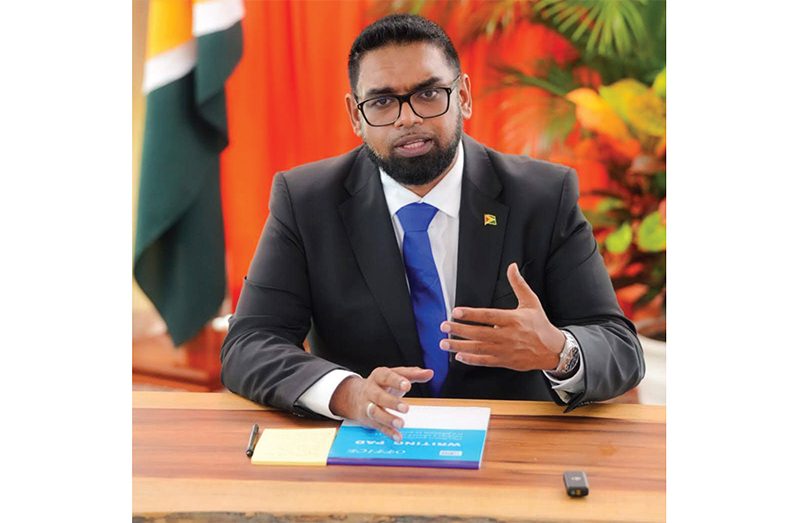GIVEN Guyana’s burgeoning growth and escalating energy demand, government is mulling plans for a second gas plant, signalling a strategic move towards energy self-sufficiency.
President Dr. Irfaan Ali made this announcement recently during an engagement with the Guyanese Diaspora in Saint Lucia, where he talked about the ongoing developments taking place in Guyana, while citing the nation’s ambition to transition into a net energy exporter.
“Whilst we are doing all of this, looking at the type of requests that we are having by then, by the time we get up to the next two years, we will need that additional power. So, we are already looking at the possibility of a second, power plant,” President Ali said.
The ongoing gas-to-shore project, leveraging natural gas from the Liza Phase One and Two Floating, Production, Storage, and Offloading (FPSO) vessels, channelling it through a 200km, 12-inch diameter pipeline to a new power plant and Natural Gas Liquids (NGL) facility at Wales, where the 300MW power plant will generate electricity for domestic use.
ExxonMobil Guyana, along with partners Hess and CNOOC, through their subsidiary Esso Exploration and Production Guyana Limited (EEPGL), has provided an assurance to the government that a minimum of 50 million standard cubic feet of gas per day (mmscfd) will be transported via the pipeline by 2024.
The pipeline, with an estimated cost of $1 billion, will be able to transport a maximum of 130 million standard cubic feet per day. The GTE project offers the dual benefits of reducing energy costs and meeting the increasing electricity demand in Guyana, which is estimated to reach nearly 1,000 megawatts by 2030.
Guyanese consumers could expect a 50 per cent reduction in electricity rates by mid-2025, in keeping with the People’s Progressive Party/Civic (PPP/C) government’s commitment to energy sustainability and reduced costs.
Consultant for the Ministry of Natural Resources, Winston Brassington recently explained that this initiative is poised to transform the energy landscape in Guyana, offering a sustainable and cost-effective alternative to the current energy mix.

The project, with a price tag of just under US$2 billion, aims to complete the necessary transmission lines and substations by the end of the year, ensuring a seamless distribution network along the Demerara Berbice Interconnected System (DBIS).
By providing a more reliable and cost-effective energy source, the initiative could drastically reduce the frequency and duration of power outages while also cutting the cost of electricity from the current US$0.25/0.36 per kWh to an affordable US$0.06/0.07 per kWh.
Such improvements would not only enhance the quality of life for Guyanese but also foster a more conducive environment for business and industry growth.
“The pipeline and the transmission work will be completed this year… resulting in the 50 per cent reduction in GPL rates which we project to happen by mid-next year,” Brassington said, highlighting the project’s potential to alleviate one of the region’s highest energy costs.
The GTE project not only promises to significantly reduce energy costs but also to meet the growing demand for electricity in Guyana, which is projected to reach almost 1,000 megawatts by 2030.
With approximately 40 per cent of the onshore pipeline and 55 per cent of the offshore portion completed, the nation is on the brink of a major energy transformation that could set a precedent for sustainable development in the region.
The Government of Guyana has earmarked $80 billion in the 2024 budget for the project, highlighting its significance to national development.
Moreover, in December 2022, the government and US-based LINDSAYCA, in collaboration with the local CH4 Group, signed a US$759 million contract for constructing the power plant and NGL facilities, reinforcing the project’s momentum.
Progress is currently being made on the 165MW Amaila Falls Hydropower Project.
The AFHP programme was shelved following the APNU+AFC taking office in 2015; however, the PPP/C administration since entering office in 2020 has sought to breathe new life into the project as the party strives to achieve energy security through an energy mix.
Several companies, including Brazilian, Austrian, and North Korean investors, have expressed interest in bidding to construct the project.
The AFHP is a significant addition to Guyana’s energy sources, as they are currently working on building a 0.15MW Hydro power plant in Kato, Region Eight, a 1.5 MW hydropower facility in Kumu, and the refurbishment and enhancement of the 700 kW Moco-Moco hydropower plant in Region Nine.













